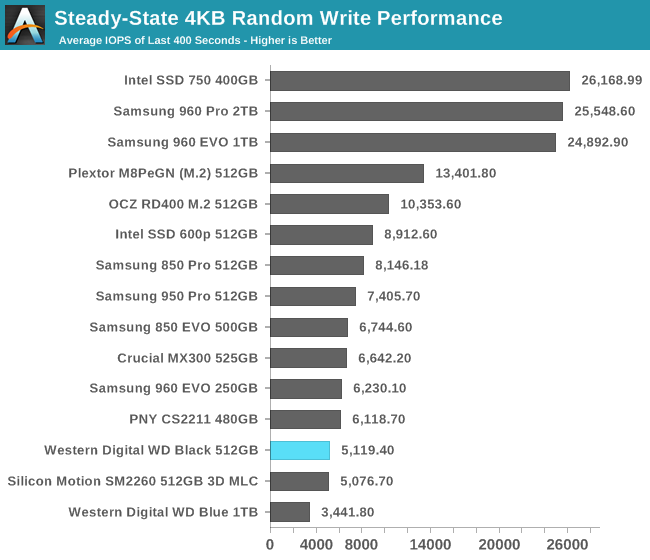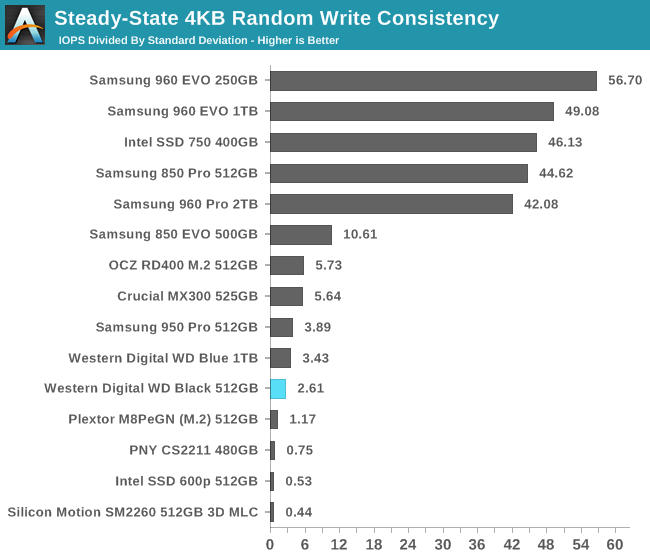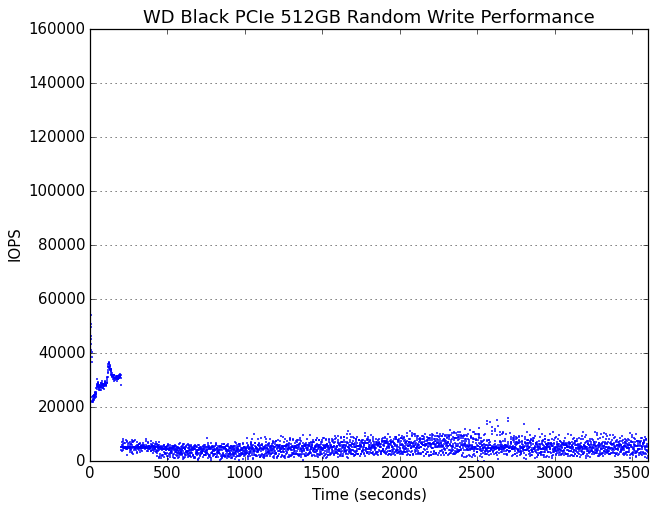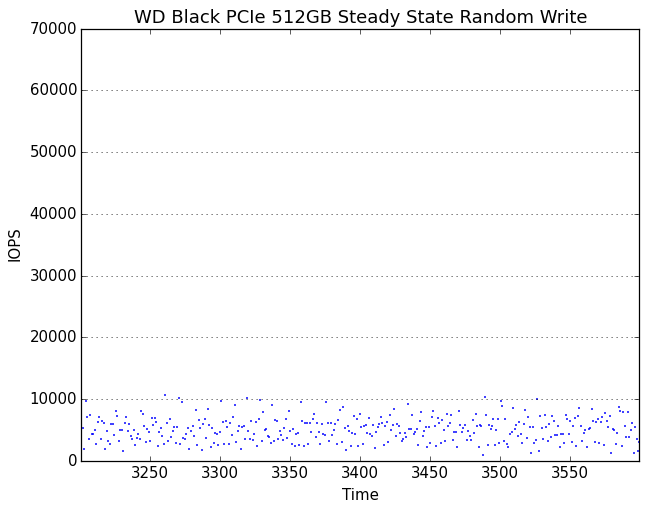The Western Digital Black PCIe SSD (512GB) Review
by Billy Tallis on March 8, 2017 8:30 AM ESTPerformance Consistency
Our performance consistency test explores the extent to which a drive can reliably sustain performance during a long-duration random write test. Specifications for consumer drives typically list peak performance numbers only attainable in ideal conditions. The performance in a worst-case scenario can be drastically different as over the course of a long test drives can run out of spare area, have to start performing garbage collection, and sometimes even reach power or thermal limits.
In addition to an overall decline in performance, a long test can show patterns in how performance varies on shorter timescales. Some drives will exhibit very little variance in performance from second to second, while others will show massive drops in performance during each garbage collection cycle but otherwise maintain good performance, and others show constantly wide variance. If a drive periodically slows to hard drive levels of performance, it may feel slow to use even if its overall average performance is very high.
To maximally stress the drive's controller and force it to perform garbage collection and wear leveling, this test conducts 4kB random writes with a queue depth of 32. The drive is filled before the start of the test, and the test duration is one hour. Any spare area will be exhausted early in the test and by the end of the hour even the largest drives with the most overprovisioning will have reached a steady state. We use the last 400 seconds of the test to score the drive both on steady-state average writes per second and on its performance divided by the standard deviation.

The WD Black has a respectable steady-state random write speed for a drive with planar TLC NAND, but the drives with 3D TLC are all faster. The Plextor M8Pe using the same controller but MLC is more than twice as fast. The SATA-based WD Blue that uses the same NAND is substantially slower despite having twice the capacity.

The WD Black's consistency score isn't in the gutter and is actually more than twice the Plextor M8Pe's score, but it's still far below the scores of the drives that are both fast and steady.
 |
|||||||||
| Default | |||||||||
| 25% Over-Provisioning | |||||||||
The WD Black runs out of spare area about four minutes into the test and abruptly transitions to its steady state. The performance consistency gets gradually worse over the course of the test but the average stays the same. With extra overprovisioning, the WD Black hovers around 33k IOPS with good consistency before transitioning to steady state.
 |
|||||||||
| Default | |||||||||
| 25% Over-Provisioning | |||||||||
By the end of the test, the WD Black's steady state performance is varying from just under 1k IOPS to just over 10k IOPS. With extra overprovisioning, the WD Black is mostly staying between 10k and 30k IOPS.










36 Comments
View All Comments
jjj - Wednesday, March 8, 2017 - link
At least it beats the Intel lolSuch a pity that SSD makers are messing around with slow options.
As NAND prices rise, the controller becomes a smaller % of the costs so offering great perf per $ is easy, as long as you have the perf and they don't.
I do have a bit of an objection to the way you talk about the 960 EVO in your conclusions.
You haven't tested the 500GB version or at least it's not in the graphs or bench and it's hard to be accurate in estimating its perf due to the SLC cache. A review for it would be nice and maybe the very popular MyDigitalSSD.
Gothmoth - Wednesday, March 8, 2017 - link
slow options are not bad if they would give me 2 TB for 200$... :)but this is just crappy stuff.
jjj - Wednesday, March 8, 2017 - link
Slow options with PCIe x4 drives so these things that offer too little over SATA.They make sense for OEMs in laptop and SFF, lower mechanical volume but the opportunity to make a buck is bigger with faster drives right now.
ImSpartacus - Thursday, March 9, 2017 - link
Yeah, pcie drives busy doubt make sense for the budget market at the moment.It's just an unnecessary cost for a use case that doesn't need the extra benefit. 2.5" sata drives can get too cheap and are too versatile.
theuglyman0war - Sunday, March 12, 2017 - link
Whats everyone complaining about? It's a.... OOPs! Read the that 800MB/s as if that was 800GB size for $199..LOL! nevermind...
Samus - Thursday, March 9, 2017 - link
I'd as clueless as everyone else as to why non-3D TLC is even a thing, especially in a product not limited by SATA.Bruce427 - Monday, March 13, 2017 - link
** A review for it would be nice [on] the very popular MyDigitalSSD. **I agree. I have one of their 480GB BPX models ($187.32) in one of my PCs and I cannot tell much difference between it and the Samsung 512GB 950 Pro.
The MyDigitals are probably the best performing lower priced NVMe drives. They also have a 5 year warranty and huge endurance (TBW) ratings.
ATB - Sunday, April 1, 2018 - link
huge endurance? Looking at 256GB size (80TBW for the WD Black) in the same price range: Intel's 600P is at 144, Kingston's KC1000 is at 300 ant Plextor's M8Pe is at... 384!!! Which means that the life-span of the black is less than 1/4 of the M8Pe's :(Mathieu Bourgie - Wednesday, March 8, 2017 - link
Reading the introduction: 'In the SATA space SanDisk has made very effective use of their planar TLC and the SanDisk X400 and WD Blue are the best in their class. 'Sure, the Sandisk X400 is a leading TLC drive, but how is the WD Blue the best in its class (and what class is that?).
From your own review of the WD Blue SSD: 'Unfortunately, the WD Blue is slower than the X400 on most other tests' and it has a 3 years warranty instead of 5 years for the Sandisk X400.
highlnder69 - Wednesday, March 8, 2017 - link
Not sure who would want to Pre-Order such a horrible performing SSD.